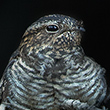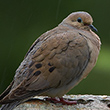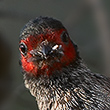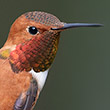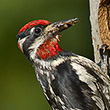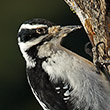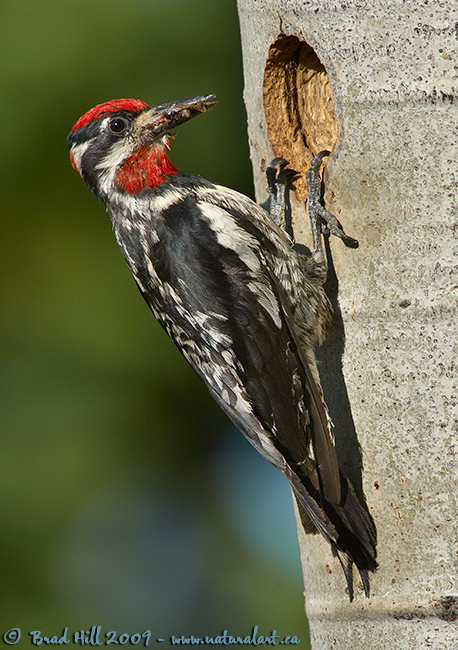
Availability: Undetermined - Enquiries?
In the Field
Classic Red-naped Sapsucker. Findlay Creek, BC, Canada. June 26, 2007.
In a sense this is the "classic" type of photo of a woodpecker - at the nest cavity with a mouthful of bugs. While technically this photo is quite good (the detail on the full-size version is phenomenal) and the composition is acceptable, I find this type of shot a little on the boring side! I've included it here to make a few points...
First, shots like this are good documentary shots - I often refer to them as "field-guide" shots. Nothing particularly outstanding from an artistic perspective, but they do show the species-specific markings and make good educational shots (for natural history slideshows or photography seminars).
Second, shooting them is great practice. This shot was taken during the early evening and to kill some heavy shadows it required a fairly intricate camera set-up, including the use of an off-camera flash-fill.
What about saleability? Well, if you market the image well enough you may find the odd person who would like it as a limited edition print. Alternately, it may do well as a postcard. But, if you are counting on the proceeds from these type of images to pay the bills, you might find that you're eating a lot of Kraft Dinner! But if you're happy with the resulting image, and you enjoy the process of capturing it, just go ahead and keep shooting images like this (just for the love of it!).
Behind the Camera
Classic Red-naped Sapsucker. Findlay Creek, BC, Canada. June 26, 2007.
Digital Capture; Uncompressed RAW (NEF) format; ISO 125.
Nikon D2Xs with with Nikon 200-400 mm f/4G ED-IF AF-S VR lens @ 400 mm paired with 1.4X Nikon TC-14E II teleconverter (840 mm equivalent with digital conversion factor) supported on Gitzo 1348 carbon fibre tripod with Wimberley head. VR turned to "On" and in "Normal" mode. SB-800 flash (fill) with Better Beamer Flash Extender mounted on Really Right Stuff flash bracket - flash mounted off-camera on separate tripod.
1/180s @ f10; -0.33 stop exposure compensation from matrix-metered exposure setting; -0.67 stop compensation on balanced flash fill.
At the Computer
Classic Red-naped Sapsucker. Findlay Creek, BC, Canada. June 26, 2007.
RAW Conversion to 16 bit TIFF, including first-pass sharpening using Phase One's C1 Pro.
Further digital correction on 16-bit TIFF file using Adobe's Photoshop CS3 and LightZone 3. Minor tonal adjustments performed in LightZone (using the ToneMapper/Relight tool). Photoshop adjustments included selective application of curves adjustment filter and selective sharpening for web output.
Conservation
Classic Red-naped Sapsucker. Findlay Creek, BC, Canada. June 26, 2007.
Ten percent of the revenue generated by this image will be donated to Wildsight.
Species Status in Canada*: This species is not designated as at risk.
The Red-naped Sapsucker (Sphyrapicus nuchalis) is found in the mountains and foothills of western North America. In the coastal regions to the west the Red-naped Sapsucker is replaced by the Red-breasted Sapsucker (S. ruber). To the east it is replaced by the physically very similar Yellow-bellied Sapsucker (S. varius). Together these three species comprise a "superspecies" (all 3 are thought to have evolved from a single species that was later split into three geographically distinct populations that, over time, "drifted" in their physical and behavioural characteristics).
All 3 species are referred to as "sapsuckers" because these birds create sap wells in the bark of trees and other woody plants and feed on the sap that fills the wells.
This female Red-naped Sapsucker was photographed in the Columbia Valley of the East Kootenays. While this species is not considered at risk, many ecosystems, including wetlands and marshes, within the Columbia Valley face development pressure. Wildsight is an effective conservation organization that protects biodiversity and promotes sustainable communities in Canada's Columbia and Rocky Mountains. Wildsight is currently investing considerable effort to sustain and conserve the Columbia Wetlands, which at 180 kilometres in length, is one of North America's longest contiguous wetland systems. Support for Wildsight, through donation or becoming a member, will help ensure that they remain effective in their efforts to conserve threatened or endangered species and ecosystems.
*as determined by COSEWIC: The Committee on the Status of Endangered Wildlife in Canada


















